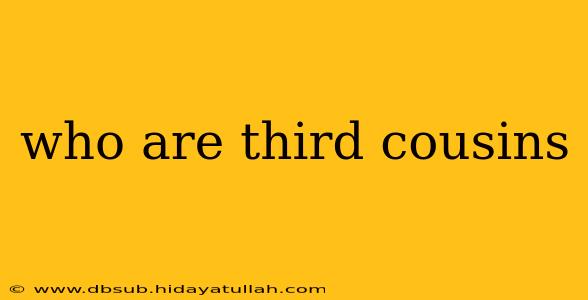Figuring out the intricacies of family relationships can be tricky, especially when you delve beyond the immediate family. Understanding the relationship of third cousins, in particular, often leaves many people scratching their heads. This post aims to clearly define third cousins and explain how this familial connection is established.
What are Third Cousins?
Third cousins share a common ancestor three generations back. Think of it this way: your great-grandparents are one generation removed from you (your grandparents are one generation, your parents are two, and you are the third generation). If your great-grandparents also happen to be the great-grandparents of another person, you are each other's first cousins. Now, if you and that person each have a child – those children are second cousins. Finally, if those second cousins each have children, those children are third cousins.
To illustrate further, consider this example:
- Great-Grandparents: These are the common ancestors.
- Grandparents (Generation 1): Each great-grandparent has children (your grandparents and the grandparents of your third cousin).
- Parents (Generation 2): Your parents are children of your grandparents. Similarly, the parents of your third cousin are children of their grandparents.
- You and Your Third Cousin (Generation 3): You and your third cousin are the third generation removed from the shared great-grandparents.
The Degree of Relatedness
The degree of relatedness between third cousins is relatively distant. While you share a common ancestor, the amount of shared DNA is considerably less than that of closer relatives like siblings, first cousins, or even second cousins. This means you might not share many noticeable physical similarities or personality traits.
Why Understanding Family Relationships Matters
Understanding family relationships, even distant ones, can be important for various reasons:
- Genealogy Research: Tracing your family history becomes much easier when you understand the different degrees of kinship.
- Medical History: Knowing your extended family's medical history can provide valuable insights into potential health risks. While the shared DNA is minimal with third cousins, it still holds some significance for genetic research.
- Social Connections: Connecting with distant relatives can enrich your life and provide a broader sense of belonging.
- Legal Matters: In certain legal situations, understanding family relationships can be crucial in inheritance or other legal issues.
Third Cousins vs. Other Relationships: Clearing Up Confusion
It's easy to confuse third cousins with other familial relationships. To avoid this, remember the key difference is the number of generations back to the common ancestor: three generations for third cousins. This contrasts with:
- First Cousins: One generation removed from the common grandparents.
- Second Cousins: Two generations removed from the common great-grandparents.
- Fourth Cousins: Four generations removed from the common great-great-grandparents.
By understanding the generation gap from the shared ancestor, you can accurately identify and appreciate the relationships within your extended family tree. This knowledge empowers you to effectively connect with your family history and potentially uncover fascinating family stories.
